|
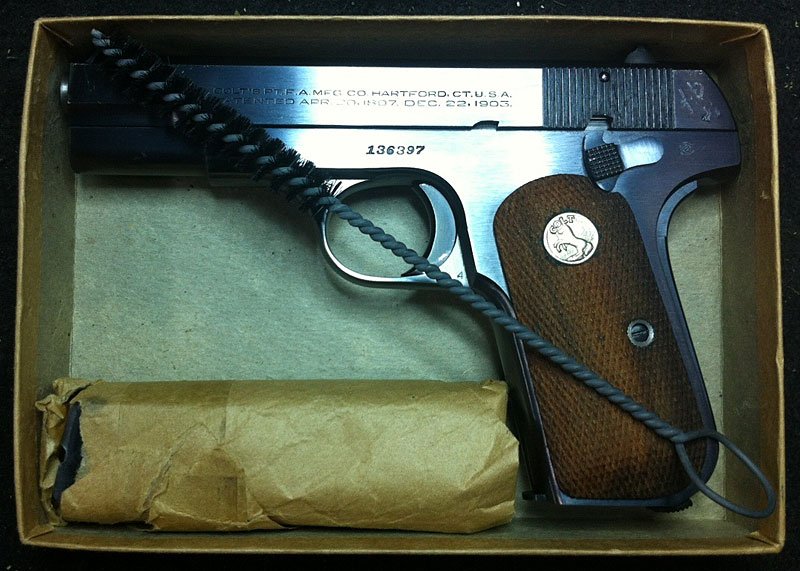
Private Collection
Colt Model M .380 ACP serial number 136397 -
Military Model M .380 ACP pistol, original blue finish with U.S. PROPERTY
mark on right side of frame and ordnance wheel on left rear
of frame behind thumb safety. Pistol was issued to Brigadier General
Norman Foster Ramsey and
is pictured with its original serial numbered kraft two
piece box with cleaning brush, and spare wrapped magazines.
Pistol remains in the family where it will be passed from
generation to generation.
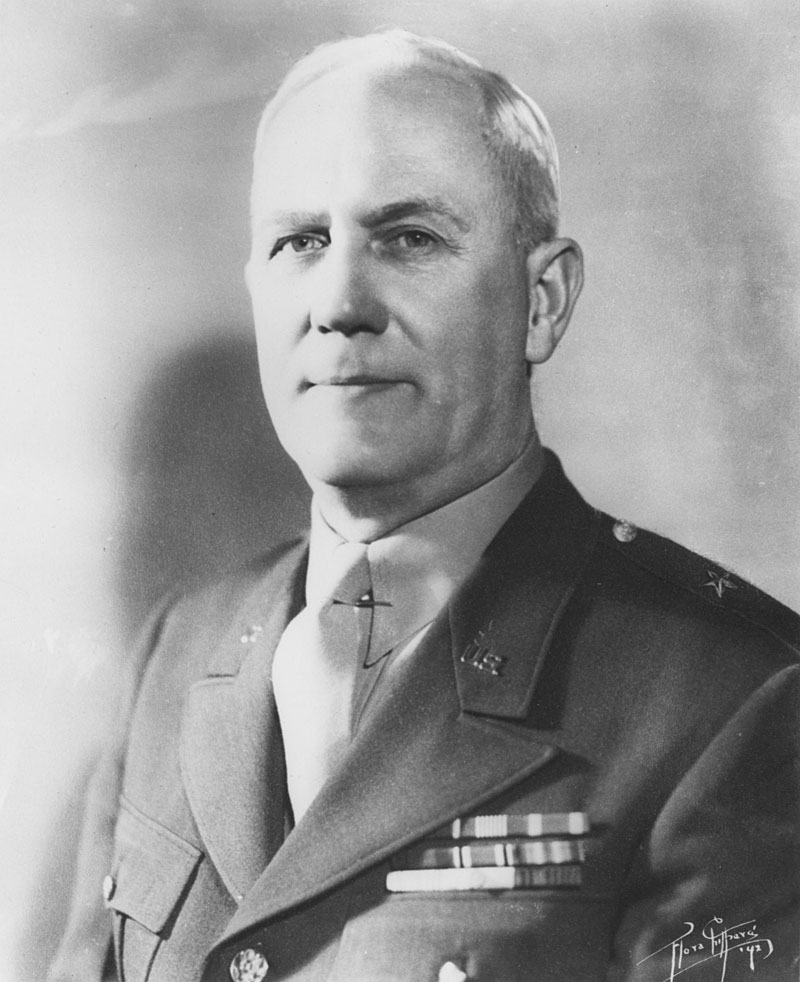
Brigadier General Norman F. Ramsey
Born in Oakdale, Illinois in 1882, at age three Norman
Ramsey moved to Kansas with his family. Two months before
his 16th birthday he enlisted in the 20th Kansas Infantry
Volunteer Regiment during the Spanish-American War. Ramsey
and the 20th Kansas Infantry served in the Philippines
Insurrection Campaign. He was discharged from the 20th
Kansas Volunteers in 1899 with the rank of corporal. He was
appointed to the United States Military Academy and
graduated President of his Class in 1905.
Initially an Infantry officer, he received detail
assignments to ordnance before being transferred to the
Ordnance
Department in 1920. This included a tour as Assistant to the
Office in Charge of Shops and then Chief Engineer, at Rock
Island Arsenal while the Arsenal was building the recoil
mechanisms for the French 75mm howitzer, a weapon widely
credited with turning the tide of WWI in favor of the
Allies. Of greatest significance prior to his transfer to
Ordnance, Ramsey was Liaison Officer to the French Artillery
and Assistant Military Attaché, Paris, France. He was later
the Chief Ordnance Officer, Service of Supply, US 3rd Army;
Chief of Supply Division, Office of Chief Ordnance Officer,
American Expeditionary Forces (AEF), France. Assistant to
Chief Ordnance Officer, AEF. A large portion of his duties
were related to closing out Ordnance accounts with the
Allies, but these assignments were beneficial to support of
the Army in France and as grounding in field Ordnance
operations. In recognition of his services Ramsey was
awarded Officer of the Black Star (France) and elected as
Officer of the Order of the Crown (Rumania).
Prior to World War II, his most significant assignment
was as commanding officer of Picatinny Arsenal, Dover, New
Jersey, from 1922-1926. By the time Major Ramsey was
commander of the Arsenal its workforce was well-known for
its expertise in the field of technical explosives. Ramsey
was Commander of Picatinny Arsenal just as the command was
hitting its stride as the premier location of munitions
development and proof testing. Ramsey oversaw all aspects of
the munitions work there. During this time, he was commended
twice for heroic acts. On May 28, 1925, he entered a burning
building containing loaded bombs and explosives to assist in
rescuing an injured civilian employee. On December 8, 1927
Major Ramsey was awarded the Soldier's Medal For Heroism for
his actions of July 11, 1926 during the famous explosion at
Lake Denmark Naval Base, which was adjacent to the Arsenal.
The citation on the Soldier Medal certificate reads:
On 11 July 1926, during the explosions at the Lake
Denmark Naval Ammunition Depot, near Dover, NJ,
Major Ramsey in charge of a party of 8 [eight] men, in
close proximity to burning magazines and exposed to
frequent explosions, searched for and located the body
of Lt. George W. Bott, Jr., USA, who had been killed by
the explosions, and with great difficulty succeeded in
removing it from the wreckage.
In the mid-1930s the Ordnance Department became serious
about expansion of its ordnance facilities. In 1936 Chief of
Army Ordnance Major General William H. Tschappat appointed
Ramsey to chair of a board of five ordnance officers, who
were to assess ordnance manufacturing, storage, and
maintenance facilities and plan for their future expansion.
From December 1936 to April 1937, he chaired the board that
became known as the "Ramsey Board".
During his Army career, BG Ramsey commanded three of the six
Army arsenals that in the pre-World War II years had formed
the cornerstone of our nation's ordnance research and
development and production. While he made many significant
contributions to Army Ordnance, BG Ramsey’s greatest
accomplishments were while he commanded at Rock Island
Arsenal (RIA). BG Ramsey is synonymous with the success of
Rock Island Arsenal in WWII when Rock Island was the largest
manufacturing plant and was critical to the US. Army as
well as the British and other allied forces. Under his
outstanding leadership, the Rock Island Arsenal not only
produced great quantities of war materials, it also served
as a research laboratory, a master Army depot, an
instructional center for commercial firms converting to war
production, and a key link in the supply of US materiel to
Great Britain and the training of British forces to maintain
that equipment. During his tenure the Rock Island Ordnance
Center was established as an "umbrella" organization
covering the Rock Island Arsenal (RIA), Rock Island Ordnance
Depot, and Sub-Office of the Office of the Chief of
Ordnance, Washington, DC.
During the early years of his Rock Island command and
into WWII BG Ramsey was responsible for developmental
prototype projects and production of artillery carriages;
self-propelled carriages; recoilless gun carriages;
halftrack vehicles; transport wagons; light, medium, flame
throwing tanks; armored car turrets; hydropneumatic recoil
mechanisms, gun mounts for airplane armaments, mortar
mounts, and rocket launchers. He was commander when the M2
tank was developed, when the Arsenal did prototype work on
the M3 Grant, and when RIA did similar work on the T7. BG
Ramsey was also significant in small arms production as the
Arsenal produced 84,945 machine guns and 715,000 machine gun
barrels in World War II. RIA also overhauled 109,073 machine
guns and 133,435 .30 caliber rifles of various types during
the war. This development and manufacture expertise was
significant as the Ordnance Department mobilized for WWII.
Besides this key development and production work BG
Ramsey was instrumental in supplying parts to the Army at
war. He was also in command of the Rock Island Ordnance
Depot, one of only four Army master depots during WWII.
Master depots stocked every item required for the
maintenance of certain classes of materiel. Rock Island
Ordnance Depot was responsible for artillery, tank, tractor,
small arms parts and supplies. The size and scope of being a
master depot required other changes. Ramsey oversaw the
construction of Rock island’s Building 299, which remains
the world's largest ordnance storehouse. Building 299 covers
approximately 17.7 acres under one roof with space enough
for 17 football fields inside. This structure was equipped
with rail tracks and could load and unload a complete train
at its interior docks.
BG Ramsey was also critical to Ordnance in his
appreciation for developing manufacturing expertise. In 1937
he reestablished the Rock Island Arsenal Machinist
Apprentice School, which provided critically needed skilled
craftsmen for ordnance production during the war. In the
early part of WWII BG Ramsey seized the initiative and
personally pledged greater assistance to commercial firms
interested in converting their plants to defense production.
As such he was an important player in the Ordnance
Department’s efforts to develop a partnership with private
industry. The forming of such an Industrial-Ordnance Team
was key to Allied victory in World War II.
BG Ramsey was especially important in partnering with the
British in WWII. As commanding general of RIA, and later the
Rock Island Ordnance Center, BG Ramsey was of great
assistance to the British Army Staff during the emergency
created by the Battle of Britain in 1940. He was responsible
for the preparation and dispatch of artillery equipment and
other war materiel from Rock Island to the United Kingdom
during the crisis. The war material was so critically needed
by Great Britain that British liaison officers were assigned
to Rock Island Arsenal to coordinate the shipments of
ordnance from the Arsenal.
BG Ramsey knew that it would not be enough to ship
materiel. He personally directed preparation for a British
detachment to spend two months at Rock Island Arsenal
studying recoil mechanisms produced at the arsenal to
familiarize them with the weapons that the British were
receiving from the United States. The British Army Staff and
War Office was so impressed by BG Ramsey's leadership that
the British Government awarded him a citation as Honorary
Commander, Military Division of the most Excellent Order of
the British Empire for service rendered during World War II.
This special ceremony took place off shore in New York City
on board the RMS Britannic during the summer of 1948.
Since his death the Army has honored BG Norman F. Ramsey
with two dedications. On September 25, 1964, Picatinny
Arsenal dedicated the Arsenal's Quality Evaluation
Laboratory, as the Norman F. Ramsey Building. More than 200
key civilian and military leaders attended the dedication.
On June 17, 1967 the Rock Island Arsenal dedicated a newly
constructed combat vehicle test track in his honor. The
54,487 foot, figure-eight track, was constructed to test the
quality and reliability of combat vehicles rebuilt at the
Arsenal.
Brigadier General Norman F. Ramsey’s contributions to
Ordnance are extensive and were, in his career, critical to
the
Ordnance manufacturing system and led to critical
contributions to the WWII victory effort. He was
admitted to the U.S. Army Ordnance Corps Hall of Fame.
Brigadier General Norman F. Ramsey's son Norman F. Ramsey
Jr., a physicist, received the Nobel Prize in Physics
for his work on the atomic clock.
SIGNIFICANT AWARDS, CITATIONS AND DECORATIONS:
- Legion of Merit
- Soldiers Medal
- Army Commendation Medal
- Purple Heart with Valor Device
- Philippine Campaign Medal
- Philippine Congressional Medal
- Spanish War Service Medal
- World War I Victory Medal
- Commander, Military Division of the Most Excellent
Order of the British Empire - June 1948
- Officer of the Legion of Honor (France)
- Officer of the Black Star (France)
- Officer of the Order of the Crown (Rumania)
OTHER HONORS:
- 1905 - Elected class president of his West Point
Class of 1905
- 1942 - Honorary degree, Doctor of Laws, St. Ambrose
College, Davenport, IA.
- 1964 - Dedication of the Norman Ramsey Quality
Evaluation Laboratory Building at Picatinny Arsenal,
Dover, NJ
- 1967 - Dedication of the Ramsey Combat Vehicle Test
Track at Rock Island Arsenal, Rock Island, Illinois.
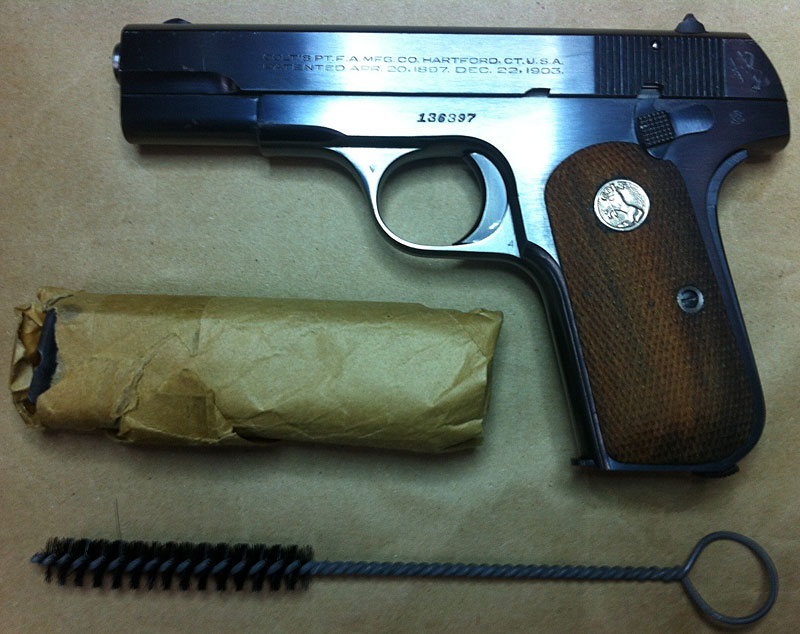
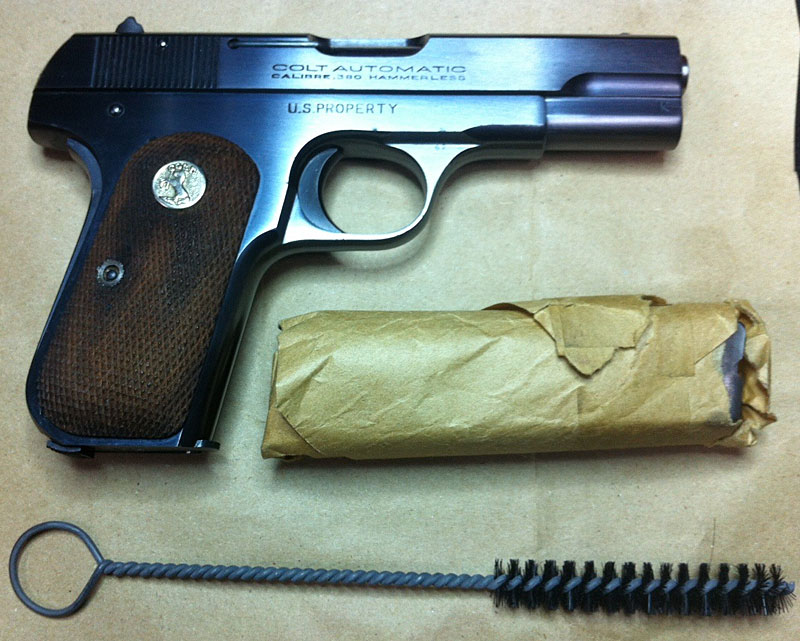
Colt 1908 Pocket Hammerless .380 ACP issued to
Brigadier General Norman F. Ramsey - serial number
136397 right side pictured with original wrapped magazine
and twisted wire cleaning brush.
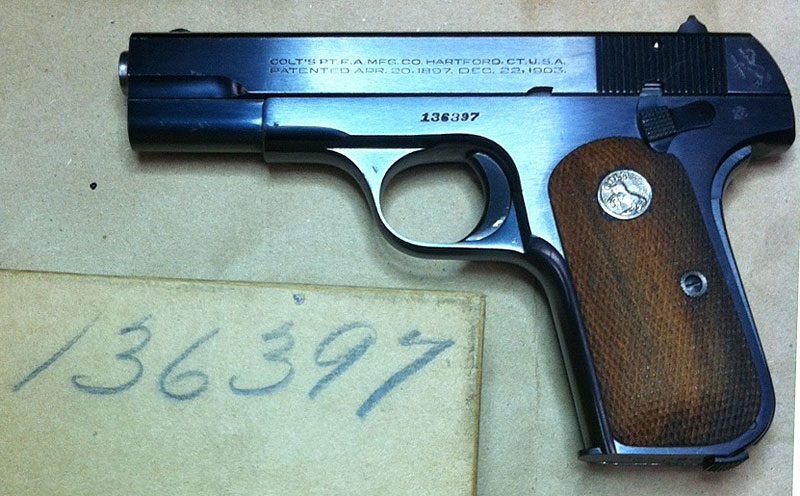
Colt 1908 Pocket Hammerless .380 ACP issued to Brigadier
General Norman F. Ramsey - serial number
136397 left side pictured with original kraft two piece box
numbered to the gun.
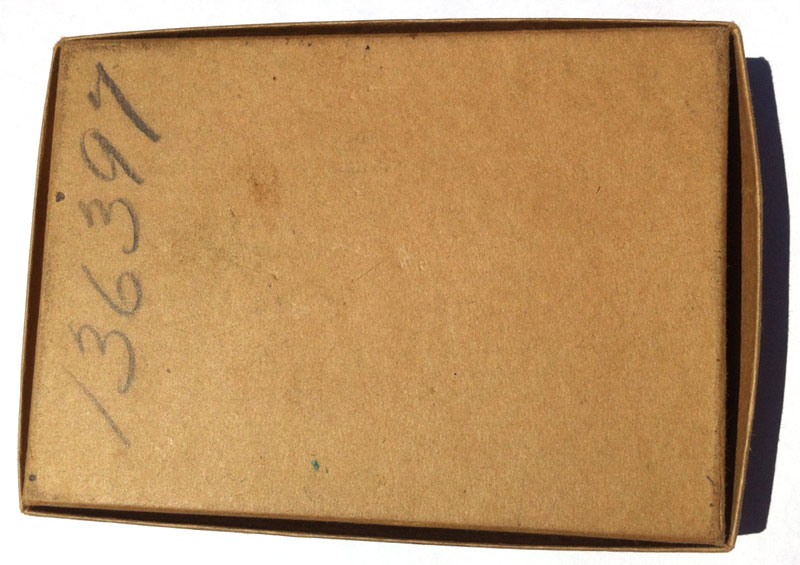
Colt 1908 Pocket Hammerless .380 ACP issued to Brigadier
General Norman F. Ramsey - original kraft two piece box
with hand written serial number 136397.
|
BRIGADIER
GENERAL NORMAN FOSTER RAMSEY |
| 9 July 1882 |
|
Oakdale, Illinois |
| 1899 - 1900 |
|
Washburn College, Topeka, Kansas |
| 1901 - 1905 |
|
United States Military Academy |
| 1920 - 1921 |
|
United States Army War College |
| 1926 - 1927 |
|
United States Army Command and
General Staff School |
| Oct 1898 - Jun 1899 |
|
Private, then Corporal, Company E,
20th Kansas Volunteer Infantry, Spanish-
American War: Participated in campaigns in the
Philippine Islands. |
| 1901 1905 |
|
United States Military Academy |
| Oct 1905 - Jun 1907 |
|
Second Lieutenant, Philippine
Islands: 2nd Battalion, US 9th Infantry, officer for
Battalion Quartermaster and Commissary. |
| Aug 1907 - Jun 1909 |
|
First Lieutenant, Sandy Hook Proving
Ground, New Jersey: Property Officer,
Assistant to Officer in charge of Ordnance School of
Application, in charge of machine shop and
supervision of armament work in Sandy Hook District;
Disbursing Officer and Assistant Proof Officer. |
| Aug 1909 - Sep 1911 |
|
Detail to Ordnance Department as
student officer at Watertown Arsenal, Mass., taking
practical shop course. At times in charge of machine
and blacksmith shops and quartermaster and
commissary. |
| Sep 1911 - Jun 1912 |
|
First Lieutenant, US 4th Infantry
Fort Logan H. Roots, Arkansas;
Participated in flood relief at Hickman, KY and New
Madrid, MO. |
| Jun 1912 - Aug 1916 |
|
Captain, detailed to Ordnance
Department, Assistant to the Chief of Ordnance,
Washington, DC |
| Jul 1916 - Sep 1918 |
|
Lieutenant Colonel, Chief Engineer,
Rock Island Arsenal (RIA). Major, Ordnance,
Department (Detail), Asst to Officer in Charge of
Shops at RIA, Rock Island, IL. |
| Oct 1918 - Apr 1920 |
|
Liaison Officer with the Direction
d'Artillerie and Assistant Military Attaché, Paris,
France. Chief Ordnance Officer, Service of Supply,
US 3rd Army; Chief of Supply Division, Office of
Chief Ordnance Officer, American Expeditionary
Forces (AEF), France. Assistant to Chief Ordnance
Officer, AEF. |
| 27 Aug 1920 |
|
Transferred to Ordnance Corps |
| Jun 1921 - Sep 1922 |
|
Major, Office, Assistant Secretary
of War, Washington, DC |
| Sep 1922 - Aug 1926 |
|
Major, Commander, Picatinny Arsenal,
Dover, New Jersey |
| Jun 1927 - Jun 1931 |
|
Major, Instructor, C&CS School |
| Jun 1931 - Jun 1933 |
|
Ordnance Officer, Second Corps Area,
Governor's Island, New York |
| Jun 1933 - Jul 1937 |
|
Chief, Artillery Division,
Manufacturing Service, Office, Chief of Ordnance,
Washington, DC; Chief, Ammunition Division,
Manufacturing Service, Office,
Chief of Ordnance, Washington, DC. |
| Jul 1937 - Oct 1944 |
|
Commanding General, Rock Island
Ordnance Center, Rock Island, IL.; Commanding
General, Rock Island Arsenal, Rock Island, IL.;
Commander, Rock Island Arsenal,
Rock Island, IL. |
| Jul 1944 |
|
Retired, but retained on active
duty. |
| Oct 1944 - Nov 1945 |
|
Commanding General, Springfield
Armory, Springfield, MA |
| Nov 1945 |
|
July 1944 Retired but retained on
Active Duty. Retired Nov 1945 |
| 11 April 1963 |
|
Deceased |
|